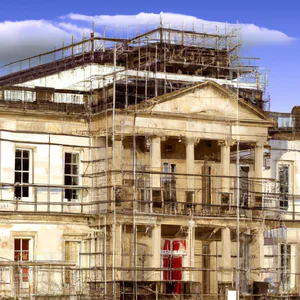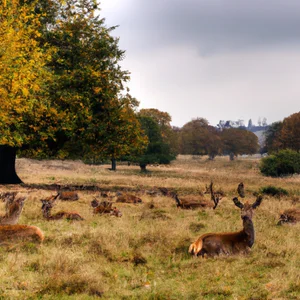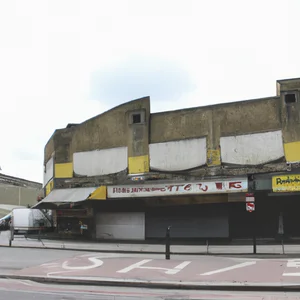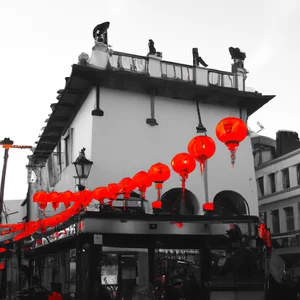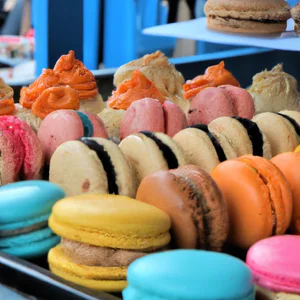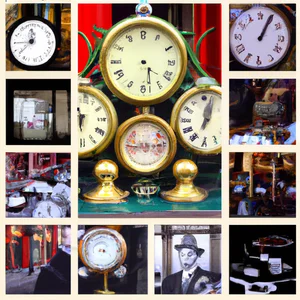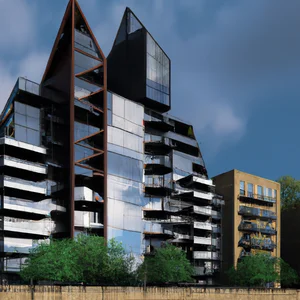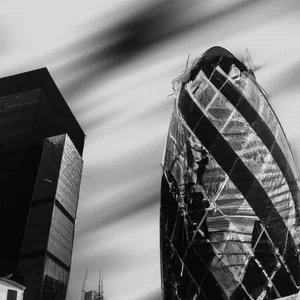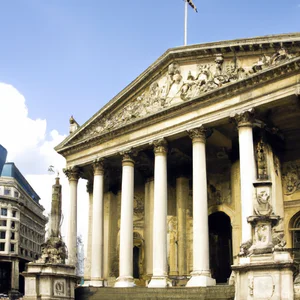Book your experience
Natural History Museum: Masterpiece of Victorian architecture and temple of science
The Natural History Museum is truly a gem, eh! I don’t know if you’ve ever been there, but it’s one of those things that leaves you speechless. We are talking about a masterpiece of Victorian architecture, for heaven’s sake! It’s like being in a fairytale book, with those ornate facades and the air that smells of history.
When you enter, it almost feels like time travel, and you don’t expect it, but you feel like an explorer. There’s a whole world to discover in there! I mean, who wouldn’t be fascinated by a giant whale suspended in the ceiling? It’s as if he were telling you: “Hey, look, the sea is a crazy place!”.
And then, the scientific part is a true temple of science, so to speak, a tribute to everything we have learned about our planet. There are fossils, dinosaur skeletons and, oh, let’s not forget the wonders of biodiversity! It’s a bit as if the museum were a giant family album of the Earth, with a history that unfolds through the centuries.
Honestly, I think a place like this can only inspire you. The first time I went there, it was like love at first sight. I don’t know, maybe it was the thrill of seeing a T-Rex, but I felt very small and big at the same time. It’s that feeling of connection to the past and the future that makes you think, you know?
In short, if you’ve never been, I highly recommend it. It is an experience that enriches you. It may not be for everyone, but in my opinion, it’s worth a look. And who knows, maybe we’ll even get a selfie with the whale!
Victorian architecture: a masterpiece to explore
An extraordinary encounter with the past
I vividly remember the moment I crossed the threshold of the Natural History Museum in London. The light that filtered through the large windows of the main hall illuminated the intricate marble sculptures that adorn the walls, while the heart of the structure, the famous skeleton of a diplodocus, stood majestically. It was as if I had entered a cathedral dedicated not only to the science, but also to the art of Victorian architecture. Every detail, from the architectural dots to the terracotta ornaments, told a story of innovation and ambition, reflecting the scientific fervor of the era. And it is not difficult to imagine how the great thinkers of the 19th century dreamed of this place destined to be a beacon of knowledge.
Practical information
The museum, designed by architect Alfred Waterhouse and inaugurated in 1881, is a sublime example of the neo-Gothic style, characterized by bold architectural forms and thoughtful details. The visit is free, but it is advisable to book tickets for temporary exhibitions or interactive workshops. For more details, you can consult the official website Natural History Museum.
Unconventional advice
If you want to have a truly unique experience, I recommend taking a walk in the museum garden during opening hours. While most visitors concentrate inside, the garden offers a great opportunity to admire the museum’s facade from a different perspective, away from the crowds. Additionally, you may come across outdoor science events or children’s workshops that are often held in this space.
The cultural impact
The architectural beauty of the Natural History Museum is not only an aesthetic triumph, but also an important symbol of the scientific curiosity of the Victorian era. This museum has helped transform perceptions of science, bringing knowledge to the general public and serving as an inspiration to generations of scientists and naturalists.
Sustainable tourism practices
The museum is also committed to eco-friendly practices, making sustainability a central part of its operations. For example, recycling and waste reduction systems have been implemented, and the museum participates in initiatives to raise visitor awareness of the importance of biodiversity and conservation.
Immersion in the atmosphere
Walking through the rooms, the sound of footsteps mixes with the echo of visitors’ voices and the rustle of the pages of books consulted by the curious. The atmosphere is full of wonder, while the scent of wood and stone envelops you, making every corner an invitation to explore. The Natural History Museum is a place where time seems to have stopped, allowing you to travel into the past to discover the wonders of nature.
Recommended activities
Don’t miss the chance to take part in one of the regularly held thematic guided tours, where industry experts tell fascinating stories behind the exhibitions. This will allow you to appreciate the architecture and history of the museum even more.
Common myths
A common misconception is that the museum is only for experts or children. In reality, the Natural History Museum is a place for everyone, where every visitor can find something interesting, be it a fossil, a precious stone or a taxidermied animal.
Final reflections
As I left the museum, I couldn’t help but reflect on how important it was to preserve these spaces not only as custodians of knowledge, but also as architectural monuments that connect us to the past. What is your experience with historic architecture? Have you ever stopped to think about how these places shape our understanding of the world?
Victorian architecture: a masterpiece to explore
An unexpected encounter with beauty
I still remember the moment I found myself in front of one of the most extraordinary Victorian architectures, the Royal Albert Hall in London. As I approached, its majestic red dome and decorative details glimmered in the sun. There was a group of street artists playing classical melodies, creating an almost magical atmosphere. This chance meeting made me realize that architecture is not just a question of structures, but of the emotions and stories it manages to evoke.
Extraordinary collections: treasures of science and nature
Victorian architecture collections are not limited to iconic buildings; they also extend to museums such as the Natural History Museum in London, where natural history displays offer an in-depth look at the evolution of life on Earth. The Great Hall, with its glass and iron ceiling, is a prime example of how Victorian architecture integrates with nature and science. Every corner tells stories of exploration and discovery, making it an unmissable place for anyone who wants to immerse themselves in 19th-century scientific thinking.
A unique tip: discover the ‘Secret Garden’
An insider tip? Don’t miss the Secret Garden located behind the museum. This hidden corner is a true oasis of tranquility, far from the frenzy of tourists. You can sit, read a book or simply enjoy the beauty of the Victorian gardens, a perfect contrast to the impressive architecture that surrounds you.
The cultural and historical impact
Victorian architecture had a lasting impact not only on the skylines of British cities, but also on perceptions of science and nature. During the 19th century, the Victorian period saw a flourishing of scientific curiosity and greater attention to the aesthetics of structures. Architectural design works from this period reflect an era of innovation and exploration, setting the stage for future architectural trends.
Sustainability in action
Today, many Victorian buildings have been restored with an eye to sustainability. Practices such as recovering original materials and implementing modern energy efficiency technologies have become common. This not only preserves the historical beauty, but also contributes to responsible tourism, inviting visitors to consider the importance of conservation.
Vividness and immersion
Imagine walking along the streets of South Kensington, surrounded by red brick buildings and elaborate details, while the scent of flowers from Victorian gardens envelops you. Every step is an invitation to explore not only the architectural beauty, but also the history and culture that are intertwined in this corner of London.
An activity worth trying
For an unforgettable experience, take a thematic guided tour of Victorian architecture, available in various museums and historic centres. These visits offer an in-depth look at the construction techniques and social meanings behind these magnificent structures.
Myths to dispel
A common misconception is that Victorian architecture is exclusively monumental and austere. In reality, there is a wide range of styles, from Gothic to Baroque, reflecting different cultural and artistic influences. This variety makes Victorian architecture not only fascinating but also accessible to a variety of tastes.
Final reflection
The next time you find yourself in front of a Victorian building, take a moment to consider not only its beauty, but also the history and stories that surround it. What emotions and thoughts does it evoke in you? Architecture is not just about bricks and mortar, but about human connections and shared experiences.
Guided tour: stories behind the exhibitions
A personal experience
I vividly remember my first visit to a natural history museum, where a charming curator led us through the halls. His words, full of passion, painted vivid pictures of distant times and fantastic creatures. Every object on display seemed to tell a story, and I, enthralled, found myself traveling through time. This experience made me understand the power of guided tours, which not only offer information, but also an emotional connection with the past.
Practical information
Guided tours are available at many museums, such as the Natural History Museum in London, where bookings can be made online up to a week before the visit. According to the museum’s official website, there are thematic tours that explore specific collections, such as dinosaurs or rare gems. For a more intimate experience, consider joining a small-group guided tour, which allows you to interact more with the curator and ask in-depth questions.
Unconventional advice
A secret that only insiders know is the possibility of requesting a personalized tour. Many curators are available for more in-depth discussions about the exhibits, especially if you book in advance. Don’t hesitate to express your specific interests: you may discover new stories that aren’t told in standard group visits.
Cultural and historical impact
Guided tours are not only a way to learn, but also serve as a bridge between the public and culture. They help preserve historical memory, allowing us to understand how past civilizations have influenced our present. The narrative behind the displays conveys a sense of belonging and identity, making the museum a place of reflection and learning.
Sustainable tourism practices
Taking guided tours can also contribute to sustainable tourism practices. Choosing tours led by local guides not only supports the economy, but also raises awareness regarding the conservation of cultural heritage. Many museums, such as the Natural History Museum in Berlin, have begun to integrate eco-friendly practices into their operations, from reducing promotional materials to using green technologies.
Immerse yourself in the atmosphere
Imagine walking among ancient fossils and archaeological finds, while the voice of an expert guides you through the secrets of the past. The soft lighting and the scent of ancient wood make the atmosphere almost mystical. Each room is a world unto itself, and each guided tour is an opportunity to discover the invisible ties that unite our present with the past.
An activity worth trying
For a unique experience, book a guided night tour at a local museum. Many museums offer exclusive after-hours tours, where you can explore the exhibits in an intimate and magical atmosphere, away from the hustle and bustle of the daytime crowds.
Myths and misconceptions
A common misconception is that guided tours are boring and full of technical information. In fact, a good guide knows how to make each story engaging, using personal anecdotes and tidbits that pique the audience’s curiosity and interest. Never underestimate the value of a well-structured narrative.
Personal reflection
After each guided tour, I often find myself reflecting on what I have learned and how these stories intertwine with our daily lives. What story does the museum you will visit have to tell? And what personal connections might you discover along the way?
Special events: fast-paced science and culture
An experience that remains imprinted
I remember the first time I attended a special event at the local museum: an evening dedicated to science and music. The rooms, illuminated by soft lights, were filled with enveloping melodies while experts from various scientific disciplines presented their discoveries in an original and engaging way. The atmosphere was lively, almost magical, and every corner of the museum pulsated with curiosity and innovation. That night I not only learned more about the topic, but I also felt the beauty of the intersection of art and science.
Practical information
The museum regularly offers special events that combine science, history and culture. One of the most anticipated is “Science Night”, a monthly meeting where visitors can interact with scientists and participate in live experiments. To stay updated on upcoming dates and topics covered, it is advisable to visit the museum’s official website or follow their social channels. Don’t forget to book in advance, as places are limited and fill up quickly!
An insider tip
If you want a truly unique experience, try attending an event during one of the full moon nights. Many museums organize astronomical observations in collaboration with local amateur astronomers, offering a rare opportunity to explore the night sky with industry experts. It’s a perfect way to combine science, culture and nature in one unforgettable experience.
Cultural and historical impact
The combination of cultural and scientific events not only enriches the museum’s offering, but also creates a deep bond with the community. These events serve as a platform to discuss current issues and promote scientific awareness, making the museum a vital center for public debate and education. The presence of experts and the possibility of interacting with them help to demystify science, making it accessible to all.
Sustainability in action
Many of these events are designed with a keen eye on sustainability. For example, the museum promotes the use of recyclable materials and offers plant-based catering options at its events. Participating in an event with these practices is not only a way to have fun, but also to support responsible and conscious tourism.
An activity not to be missed
During the next event, be sure to attend one of the hands-on demonstrations. There is nothing more engaging than seeing science in action, and there are often experiments that require the participation of public. It’s an experience that stimulates curiosity and leaves a lasting impression.
Myths to dispel
A common misconception is that science events are boring or too technical. In fact, these events are designed to be engaging and stimulating, suitable for all ages and knowledge levels. Science can be fun, and the museum is a great place to discover it.
A new perspective
As you prepare for your visit, ask yourself: How can science impact your daily life? Attending special events at the museum can open doors to new ideas and inspiration, making you not just a visitor, but also an actor in the scientific community. The next time you explore a museum, remember that every event is an opportunity to discover, learn, and connect with the world around you.
A unique tip: explore the lesser-known area
I clearly remember the moment I decided to go off the beaten path into a famous museum. While most visitors crowded into the main rooms, I ventured towards a secondary, little-frequented corridor. Here, I discovered a small corner dedicated to a rare collection of 19th century scientific instruments. Each object told a story, and my curiosity lit up like a light bulb: this is the true heart of the museum.
Discover the unexpected
Visiting the lesser-known area of a museum can be an extraordinary experience. Often, these sections hide less famous but equally significant works. For example, at the Natural History Museum in London, the Fossil Courtyard is a place that few visitors reach, yet it offers an enchanting view of prehistoric skeletons displayed in a natural setting that seems almost magical. It is here that you can appreciate the Victorian architectural details, with their intricate mosaics and stained glass windows, which tell of the era’s passion for science and beauty.
An insider tip
If you really want to immerse yourself in this experience, I recommend visiting the museum during less crowded opening hours, such as Monday morning or Thursday afternoon. Also, don’t forget to ask museum staff if there are any hidden areas or temporary exhibits that aren’t advertised. Often, staff members are excited to share hidden gems with curious visitors.
Cultural and historical impact
Exploring these lesser-known areas offers not only a break from the crowds, but also an opportunity to reflect on the historical and cultural importance of what you’re seeing. The extraordinary Victorian architecture of many museums is a symbol of an era in which scientific knowledge was rapidly evolving. These less frequented spaces can serve as a reminder of the curiosity and inventiveness that characterized the period.
Sustainable tourism practices
Embarking on a trip to lesser-known places in the museum promotes more sustainable tourism. This approach helps disperse crowds, reducing overcrowding in main areas and allowing for a more authentic experience. Many museums are also implementing eco-friendly practices, such as reducing plastic use and adopting renewable energy, helping to preserve cultural heritage for future generations.
Soak up the atmosphere
As you venture into these little-known areas, let the sounds and sights envelop you. The light rustle of the pages of an ancient science book, the scent of the wood of the cases that house precious finds, and the play of light and shadow created by the stained glass windows will transport you to another time. Feel the history that breathes in every corner.
An activity worth trying
I recommend you take part in a workshop or an exclusive guided tour dedicated to the less famous collections. These experiences, often available by reservation, can give you a deeper and more personal understanding of the objects on display and their stories.
Myths to dispel
A common misconception is that less visited areas are less interesting or valuable. In fact, they can prove to be the most fascinating, offering an intimate and direct look at aspects of history and science that would otherwise remain hidden.
Final reflection
The next time you visit a museum, ask yourself: what might I discover beyond the beaten path? The true magic of a museum often lies in its most remote corners, the ones waiting to be explored and appreciated. Sometimes, that’s where the most fascinating story lies.
Hidden history: the evolution of the museum over time
A journey through time through the rooms of the museum
I still remember my first visit to a museum, a place where time seems to have stopped, where every corner tells forgotten stories. It was a rainy afternoon, and as I took refuge under the grand portico of a natural history museum, I felt transported to another era. The walls, adorned with Victorian artworks, revealed not only the beauty of lavish architecture, but also the secrets of an era when science and art intertwined in surprising ways.
The evolution of museums: a mosaic of changes
Over the years, museums have undergone extraordinary transformations. Starting as simple collections of curiosities, today they have evolved into dynamic institutions that celebrate the diversity of human knowledge. Local sources such as the Natural History Museum of London document this shift, highlighting how the mission of museums has expanded to include education and sustainability. It is not just a storage room of artifacts, but a place where the past and present meet to inspire the future.
A tip for curious explorers
If you want to discover a lesser-known aspect of the museum, don’t miss the opportunity to visit its historic library. Many museums, such as the Natural History Museum, keep archives of documents and rare books that tell not only the history of the museum itself, but also the cultural and scientific context in which it was born. This corner of tranquility is a treasure for those who love to immerse themselves in research and learning.
The cultural impact of the museum
Museums are not just custodians of objects; they are also witnesses of social and cultural changes. Victorian architecture, with its decorative details and stately proportions, reflects an era of great innovation and discovery. Each room tells a chapter of the collective history, from industrialization to the emergence of modern science. Visiting a museum is like leafing through a history book where each page is a work of art.
Sustainability and responsibility
Today, many museums are adopting sustainable practices, such as using recycled materials and implementing energy saving systems. These initiatives not only protect cultural heritage, but also contribute to responsible tourism by encouraging visitors to reflect on their environmental impact. Find out about local initiatives at the museum you intend to visit; it won’t be difficult to find events that promote ecological awareness.
Final reflections
As you explore the corridors of a museum, ask yourself: What stories have been overlooked and what impact have they had on our society? The history of a museum is a journey that continues to evolve, and each visit offers the opportunity to discover new pieces of this fascinating mosaic. Are you ready to discover the hidden story that lies behind each exhibit?
Sustainability in action: eco-friendly practices at the museum
My visit to a museum dedicated to science and nature proved to be an enlightening experience not only for the incredible collections, but also for the museum’s incredible commitment to sustainability. As I walked through the rooms, observing displays of fossils and models of living organisms, I noticed drinking water accessible through drinking fountains on each floor, a simple but significant gesture that encourages visitors to reduce the use of plastic bottles disposable.
Eco-friendly practices
The museum has implemented several eco-friendly practices, including:
- LED lighting: to reduce energy consumption.
- Recycled materials: used for exhibition setups.
- Separate collection policies: to manage and reduce waste.
According to a report by the Association of National Museums, 75% of museums are taking steps to become more sustainable, and this museum is no exception. Information about sustainable practices is clearly posted, helping to educate the public about the importance of preserving our environment.
A unique tip
If you want an authentic experience, I recommend taking one of the guided tours dedicated to sustainability. Often, curators offer insights into how the museum manages its resources and the impact of exhibits on the community. This type of tour is not always advertised, but by asking at the information desk, you may find out about special dates.
Cultural and historical impact
The commitment to sustainability is not just a matter of fashion, but a reflection of the history and culture of the place. This museum, located in a city that has always cared about its natural environment, has evolved to become a pioneer in promoting responsible practices. Its Victorian architecture, with large windows and green spaces, was designed to harmonize with the surrounding landscape, underlining the importance of a sustainable existence.
Responsible tourism
In the current context, responsible tourism is fundamental. Choosing to visit places that adopt sustainable practices not only helps preserve the environment, but also enriches your experience, making it more conscious. Every small gesture counts, and the museum is a clear example of how cultural institutions can make a difference.
An activity worth trying
Don’t miss the opportunity to participate in one of the interactive workshops dedicated to sustainability, where local experts share creative recycling techniques. These experiences are not only engaging, but also offer practical tools you can take home.
Myths to dispel
A common misconception is that sustainable practices are expensive and complicated. On the contrary, many museums demonstrate that investing in sustainability can lead to long-term savings and greater public engagement.
Final reflection
As you walk away from the museum, ask yourself: How can you integrate sustainability into your daily life? Awareness starts with curiosity, and by visiting places that celebrate environmental responsibility, we can all contribute to a better future.
Local experiences: interactive workshops with experts
I still remember my first visit to the Natural History Museum in London, when, with my nose in the air, I admired the imposing skeleton of a diplodocus that dominated the central hall. But what struck me most was not only the architecture but the possibility of participating in an interactive laboratory, where industry experts guided us on a hands-on journey through the world of paleontology. That day transformed my perception of the museum, making it a place where curiosity meets practical teaching.
A unique opportunity
The Natural History Museum offers a variety of interactive workshops, designed to engage visitors of all ages. During these events, participants can work closely with scientists and curators to explore topics such as biodiversity, evolution and conservation. These workshops are not only a way to learn, but also an opportunity to ask questions and receive answers directly from those who live and breathe science every day.
- Family workshops: Hands-on activities perfect for engaging children, such as the fossil workshop, where they can “dig” and identify finds.
- Workshops for adults: More in-depth sessions on specific topics, such as sustainability or marine biology, which offer a more nuanced understanding of current challenges.
An unconventional tip for those who want to participate in these experiences is to book in advance. Many of these workshops fill up quickly, and having a guaranteed spot can make the difference between an ordinary visit and a memorable experience.
A significant cultural impact
Interactive workshops not only enrich the visitor experience, but also have a lasting cultural impact. By offering direct access to science, the museum stimulates genuine interest in the natural world, promoting science awareness and education. This is especially important in an era where sustainability and nature conservation are crucial issues.
Sustainability in action
In line with responsible tourism practices, the Natural History Museum has implemented several eco-friendly initiatives. During the workshops, participants are encouraged to reflect on the impact of their actions on the environment, learning how even small daily gestures can contribute to greater sustainability.
Immerse yourself in the atmosphere
Imagine being in a room where the scent of playdough and the sound of enthusiastic voices fill the air. Experts, surrounded by dinosaur skeletons and ancient rocks, invite you to touch, explore and discover. This is the atmosphere that makes each workshop an engaging and unforgettable experience.
Try an interactive experience
If you are planning a visit, don’t miss the opportunity to sign up for one of the interactive workshops. You can find up-to-date information on the museum’s official website, where upcoming events and registration details are listed.
Final reflections
We often think that museums are just places of exhibition, but the Natural History Museum in London demonstrates that they can also be spaces of active and engaging learning. What will be your experience in the world of science? We invite you to let curiosity guide you and discover how knowledge and art intertwine in this extraordinary temple of knowledge.
Temporary exhibitions: new things that surprise every time
An unexpected discovery
I remember my last visit to the Natural History Museum, when I was lucky enough to come across a temporary exhibition dedicated to marine fossils. Climbing the stairs to the grand entrance, my heart pounding with anticipation, I found myself faced with prehistoric creatures on display as if they were about to tell me their secrets. It’s incredible how these temporary exhibitions manage to transform the entire visiting experience. Every time you enter it, it’s as if a new chapter of a compelling book opens, ready to reveal stories from distant eras.
Practical information and updates
The museum’s temporary exhibitions are carefully curated and vary from year to year, always offering something fresh and stimulating. To stay updated on the latest exhibitions, I recommend visiting the museum’s official website or their social channels. Here you can find information on special events, opening dates and exhibition contents. For example, in 2023, the “Dinosaurs: Giants of the Past” exhibition attracted visitors from all over, demonstrating the unparalleled appeal of these exhibits.
An insider tip
If you want an experience again more engaging, try to visit during the museum’s evening openings, when temporary exhibitions come to life in a magical atmosphere. It’s a unique opportunity to explore without the daytime crowds and enjoy special events, such as talks and interactive workshops with industry experts.
Cultural and historical impact
Temporary exhibitions are not only a way to attract visitors, but also represent an opportunity for the museum to tell local and global stories. Each exhibit is designed to stimulate curiosity and encourage deeper reflection on natural history and the importance of conservation. Through these initiatives, the museum establishes itself as a bridge between past and present.
Sustainable practices
In an age where sustainability is paramount, the museum is committed to presenting exhibitions that highlight the beauty and fragility of our planet. Many of the temporary exhibitions are created in collaboration with ecological institutions, with the aim of raising public awareness of the importance of environmental conservation.
Immerse yourself in the atmosphere
Walking through the rooms, surrounded by extraordinary finds and artistic installations, the atmosphere is palpable. The soft light that filters through the windows, the muffled sounds of other visitors’ footsteps, everything contributes to creating a sense of wonder and discovery. Each temporary exhibition is an open window onto worlds that invite us to explore and learn.
An activity worth trying
Don’t miss the opportunity to take part in a guided tour dedicated to the temporary exhibitions. These tours offer a unique perspective, with the chance to hear anecdotes and curiosities that you wouldn’t find on information panels. It is ideal for those looking for a more personal contact with the exhibitions.
Myths and misconceptions
A common misconception is that temporary exhibitions are reserved only for experts or enthusiasts. In fact, these exhibits are designed to be accessible and engaging for everyone. Whether you are a science enthusiast or simply curious, you will always find something that will amaze you.
A final reflection
Next time you visit the Natural History Museum, ask yourself: What stories might the new temporary exhibitions tell? Each experience is an invitation to explore not only the past, but also our present and future. With each visit, you have the chance to discover something new, not only about the world around us, but also about ourselves.
Reflections on responsible tourism: a conscious journey
A personal anecdote
I vividly remember my first trip to a small historic town, where architecture and culture were intertwined in a fascinating embrace. Walking through the cobbled streets, I came across a group of tourists taking photos without ever looking up at the wonders around them. This meeting made me reflect on how responsible tourism can transform not only our experience, but also the way we interact with local communities and their heritage.
Practical information
Responsible tourism is based on conscious choices that enhance the environment and local cultures. According to the World Tourism Organization, traveling responsibly means respecting the traditions and ecosystem of the place we visit. For anyone who wants to dive into this approach, many cities have begun implementing sustainable practices, such as using eco-friendly public transportation and promoting community-engaged activities. Find out about local events and volunteer opportunities through sources such as the official local tourism website.
An insider tip
A little-known tip is to look for small artisan shops instead of the more commercial souvenir shops. Not only will you find unique and authentic pieces, but you will also have the opportunity to learn about local artisans and their stories. These encounters not only enrich your experience, but also help keep the local economy alive.
Cultural and historical impact
The way we approach tourism can have a profound impact on the culture and identity of a place. Responsible tourism promotes greater awareness and respect for local traditions, avoiding the trivialization of cultures. For example, in many historic cities, the increase in mass tourism has led to a loss of authenticity; supporting local initiatives can help preserve the true essence of a place.
Sustainable practices
Many museums and tourist attractions are embracing eco-friendly practices, such as using recycled materials, reducing plastic and promoting zero-emission events. Taking part in tours that use sustainable means of transport, such as bicycles or public transport, is a way to contribute to a more responsible form of tourism.
An enveloping atmosphere
Imagine walking through the streets of an ancient village, surrounded by historic buildings that tell stories of bygone eras. The air is pervaded by the scents of local cuisine, while the sound of street musicians fills the atmosphere with life. It is an experience that goes beyond a simple visit: it is an opportunity to connect with the beating heart of a place.
An activity worth trying
For an authentic experience, join a local “food circuit.” Many cities offer tours that guide you through markets and restaurants, where you can sample traditional dishes and meet the chefs who prepare them. Not only will you have the chance to taste the local cuisine, but you will also discover stories and traditions that make each dish unique.
Myths and misconceptions
A common misconception is that responsible tourism is only for “eco-conscious” travelers or those on a budget. In reality, anyone can adopt responsible travel practices, regardless of their lifestyle or resources. Even small choices, such as opting for eco-sustainable housing or limiting waste, can make a big difference.
A personal reflection
Have you ever wondered what footprint you leave when you visit a new place? Every journey is an opportunity to learn, respect and contribute. How can you make your next trip not only a memorable experience, but also an act of love towards the communities you visit? The true essence of responsible tourism is to travel with the heart, embracing the beauty and fragility of our world.

 Architecture and Design
Architecture and Design Cities and Regions
Cities and Regions Culture and History
Culture and History Events and Festivals
Events and Festivals Fashion and Shopping
Fashion and Shopping Food and Wine
Food and Wine Nature and Adventure
Nature and Adventure Unique Experiences
Unique Experiences


















